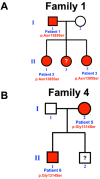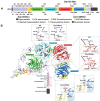Rare Variants in LRP4 Are Associated with Mesiodens, Root Maldevelopment, and Oral Exostoses in Humans
- PMID: 36829498
- PMCID: PMC9952772
- DOI: 10.3390/biology12020220
Rare Variants in LRP4 Are Associated with Mesiodens, Root Maldevelopment, and Oral Exostoses in Humans
Abstract
Background: Low density lipoprotein receptor-related protein 4 (LRP4; MIM 604270) modulates WNT/β-catenin signaling, through its binding of WNT ligands, and to co-receptors LRP5/6, and WNT inhibitors DKK1, SOSTDC1, and SOST. LRP4 binds to SOSTDC1 and WNT proteins establishing a negative feedback loop between Wnt/β-catenin, Bmp, and Shh signaling during the bud and cap stages of tooth development. Consistent with a critical role for this complex in developing teeth, mice lacking Lrp4 or Sostdc1 have multiple dental anomalies including supernumerary incisors and molars. However, there is limited evidence supporting variants in LRP4 in human dental pathologies.
Methods: We clinically, radiographically, and molecularly investigated 94 Thai patients with mesiodens. Lrp4 mutant mice were generated in order to study the effects of aberrant Lrp4 expression in mice.
Results: Whole exome and Sanger sequencing identified three extremely rare variants (c.4154A>G, p.Asn1385Ser; c.3940G>A, p.Gly1314Ser; and c.448G>A, p.Asp150Asn) in LRP4 in seven patients with mesiodens. Two patients had oral exostoses and two patients had root maldevelopments. Supernumerary incisors were observed in Lrp4 mutant mice.
Conclusions: Our study implicates heterozygous genetic variants in LRP4 as contributing factors in the presentation of mesiodens, root maldevelopments, and oral exostoses, possibly as a result of altered WNT/β-catenin-BMP-SHH signaling.
Keywords: buccal exostoses; root anomalies; root malformations; torus mandibularis; torus palatinus.
Conflict of interest statement
The authors declare no conflict of interest.
Figures







Similar articles
-
LRP4 mutations, dental anomalies, and oral exostoses.Int J Paediatr Dent. 2024 Jul;34(4):432-441. doi: 10.1111/ipd.13141. Epub 2023 Nov 27. Int J Paediatr Dent. 2024. PMID: 38013205
-
Mutations in LRP5 and BMP4 are associated with mesiodens, tooth agenesis, root malformation, and oral exostoses.Clin Genet. 2022 Oct;102(4):333-338. doi: 10.1111/cge.14183. Epub 2022 Jul 2. Clin Genet. 2022. PMID: 35754005
-
Mutations in the WLS are associated with dental anomalies, torus palatinus, and torus mandibularis.Eur J Orthod. 2023 May 31;45(3):317-323. doi: 10.1093/ejo/cjac068. Eur J Orthod. 2023. PMID: 36374649
-
Lrp4: A novel modulator of extracellular signaling in craniofacial organogenesis.Am J Med Genet A. 2010 Dec;152A(12):2974-83. doi: 10.1002/ajmg.a.33372. Am J Med Genet A. 2010. PMID: 21108386 Free PMC article. Review.
-
Cenani-Lenz syndrome and other related syndactyly disorders due to variants in LRP4, GREM1/FMN1, and APC: Insight into the pathogenesis and the relationship to polyposis through the WNT and BMP antagonistic pathways.Am J Med Genet A. 2019 Feb;179(2):266-279. doi: 10.1002/ajmg.a.60694. Epub 2018 Dec 20. Am J Med Genet A. 2019. PMID: 30569497 Review.
Cited by
-
Genetic Variants in KCTD1 Are Associated with Isolated Dental Anomalies.Int J Mol Sci. 2024 May 9;25(10):5179. doi: 10.3390/ijms25105179. Int J Mol Sci. 2024. PMID: 38791218 Free PMC article.
-
Rare Genetic Variants in Human APC Are Implicated in Mesiodens and Isolated Supernumerary Teeth.Int J Mol Sci. 2023 Feb 21;24(5):4255. doi: 10.3390/ijms24054255. Int J Mol Sci. 2023. PMID: 36901686 Free PMC article.
-
Genome scan reveals several loci associated with torus palatinus.Orthod Craniofac Res. 2025 Feb;28(1):159-165. doi: 10.1111/ocr.12857. Epub 2024 Sep 18. Orthod Craniofac Res. 2025. PMID: 39291419 Free PMC article.
-
Genetic Variants in KIF7 May Contribute to Supernumerary Tooth Formation.Int Dent J. 2025 Aug 6;75(5):100928. doi: 10.1016/j.identj.2025.100928. Online ahead of print. Int Dent J. 2025. PMID: 40774045 Free PMC article.
-
Genetic Variants in Protein Tyrosine Phosphatase Non-Receptor Type 23 Are Responsible for Mesiodens Formation.Biology (Basel). 2023 Mar 1;12(3):393. doi: 10.3390/biology12030393. Biology (Basel). 2023. PMID: 36979085 Free PMC article.
References
LinkOut - more resources
Full Text Sources
Miscellaneous

